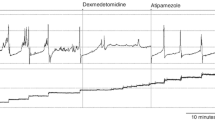Abstract
Background
To determine the effect of an adrenergic and a cholinergic antagonist on the diameter of the lumen of the nasolacrimal drainage system.
Methods
The asymptomatic side of 38 patients (29 women, nine men) with unilateral stenosis/obstruction of the nasolacrimal drainage system was studied. The tear meniscus height (TMH) of the asymptomatic side was normal, and the lacrimal drainage system was patent as revealed by dacryocystography. The nasolacrimal drainage system of the asymptomatic side was infused with 100 μl of 0.01% bunazosin hydrochloride, a selective α-1 adrenergic antagonist, or 100 μl of 0.4% tropicamide, a muscarinic and cholinergic antagonist. Dacryocystography was performed to determine the diameter of the lumen of the nasolacrimal drainage system before and after the antagonists.
Results
Bunazosin reduced the diameter of the lumen significantly, and the changes were more marked in the nasolacrimal duct (NLD), especially the middle and the lower regions. The diameter of the lumen of the lacrimal sac was not changed significantly. In contrast, tropicamide did not cause any significant change in the diameter of the lumen of the nasolacrimal drainage system.
Conclusions
The alterations of the size of the lumen of the nasolacrimal drainage system, especially the NLD, by an adrenergic antagonist suggest that the lumen diameter is under continuous sympathetic tone, and the parasympathetic tone is weak.






Similar content being viewed by others
References
Amanat LA, Hilditch TE, Kwok CS (1983) Lacrimal scintigraphy.III. Physiological aspects of lacrimal drainage. Br J Ophthalmol 67:729–732
Bojsen-Møller F, Fahrenkrug J (1971) Nasal swell-bodies and cyclic changes in the air passage of the rat and rabbit nose. J Anat 110:25–37
Delgado D, Michel P, Jaanus SD (1982) Effects of tropicamide on ocular blood flow in the rabbit. Am J Optom Physiol Opt 59:410–412
Eccles R, Wilson H (1974) The autonomic innervation of the nasal blood vessels of the cat. J Physiol 238:549–560
Eccles R (1983) Sympathetic control of nasal erectile tissue. Er J Respir Dis 64:150–154
Garay R (2004) Mechanisms of vasomotor rhinitis. Allergy 59:4–10
Gil DW, Krauss HA, Bogardus AM, WoldeMussie E (1997) Muscarinic receptor subtypes in human iris-ciliary body measured by immunoprecipitation. Invest Ophthalmol Vis Sci 38:1434–1442
Grevers G, Kamargakis WN (1995) Intervascular smooth muscle fibers and muscular bolsters in nasal swell bodies of humans. Ann Otol Rhinol Laryngol 104:144–148
Grueb M, Reinthal E, Rohrbach JM, Bartz-Schmidt KU (2006) Muscarinic acetylcholine receptor subtypes in human corneal epithelium and endothelium. Graefes Arch Clin Exp Ophthalmol 244:1191–1195
Huang TC, Lee DA (1989) Punctal occlusion and topical medications for glaucoma. Am J Ophthalmol 107:151–155
Hulme EC, Birdsall NJM, Buckley NJ (1990) Muscarinic receptor subtypes. Annu Rev Pharmacol Toxicol 30:633–673
Ichikawa M, Okada Y, Asai Y, Hara H, Ishii K, Araie M (2004) Effects of topically instilled bunazosin, an α1-adrenoceptor antagonist, on constrictions induced by phenylephrine and ET-1 in rabbit retinal arteries. Invest Ophthalmol Vis Sci 45:4041–4048
Ishibe T, Yamashita T, Kumazawa T, Tanaka C (1983) Adrenergic and cholinergic receptors in human nasal mucosa in cases of nasal allergy. Arch Otorhinolaryngol 238:167–173
Kawarai M, Koss MC (2001) Sympathetic control of nasal blood flow in the rat mediated by α1-adrenoceotors. Eur J Pharmacol 413:255–262
Lazareno S, Buckley NJ, Roberts FF (1990) Characterization of muscarinic M4 binding sites in rabbit lung, chicken heart, and NG 108-15 cells. Mol Pharmacol 38:805–815
Lidström AE (1923) Contribution to the knowledge of the incidence and treatment of the diseases of the lacrymal passages. Acta Ophthalmol 1:131–146
Lung MA, Wang JC (1989) Autonomic nervous control of nasal vasculature and airflow resistance in the anaesthetized dog. J Physiol 419:121–139
Nakaya M, Yuasa T, Usui N (2002) Immunohistochemical localization of subtypes of muscarinic receptors in human inferior turbinate mucosa. Ann Otol Rhinol Laryngol 111:593–597
Narioka J, Ohashi Y (2006) Changes in lumen width of nasolacrimal drainage system after adrenergic and cholinergic stimulation. Am J Ophthalmol 141:689–698
Paulsen F, Hallmann U, Paulsen J, Thale A (2000) Innervation of the cavernous body of the human efferent tear ducts and function in tear outflow mechanism. J Anat 197:177–187
Shell JW (1982) Pharmacokinetics of topically applied ophthalmic drugs. Surv Ophthalmol 26:207–218
Thale A, Paulsen F, Rochels R, Tillmann B (1998) Functional anatomy of the human efferent tear ducts: a new theory of tear outflow mechanism. Graefes Arch Clin Exp Ophthalmol 236:674–678
Weiter JJ, Schachar RA, Ernest JT (1973) Control of intraocular blood flow. II. Effects of sympathetic tone. Invest Ophthalmol 12:332–334
Whitnall SE (1932) The anatomy of the human orbit and accessory organs of vision, 2nd ed. Robert E. Krieger Publishing Company, New York, pp 1–252 (Reprint of original publication by Oxford University Press, London)
Zimmerman TJ, Kooner KS, Kandarakis AS, Ziegler L (1984) Improving the therapeutic index of topically applied ocular drugs. Arch Ophthalmol 102:551–553
Author information
Authors and Affiliations
Corresponding author
Additional information
This study has not received any financial support.
Rights and permissions
About this article
Cite this article
Narioka, J., Ohashi, Y. Effects of adrenergic and cholinergic antagonists on diameter of nasolacrimal drainage system. Graefes Arch Clin Exp Ophthalmol 245, 1843–1850 (2007). https://doi.org/10.1007/s00417-007-0615-4
Received:
Revised:
Accepted:
Published:
Issue Date:
DOI: https://doi.org/10.1007/s00417-007-0615-4




